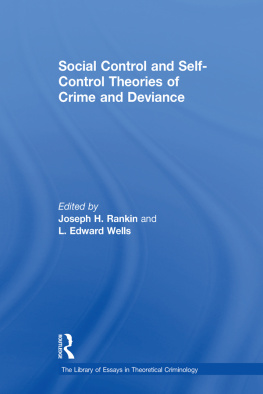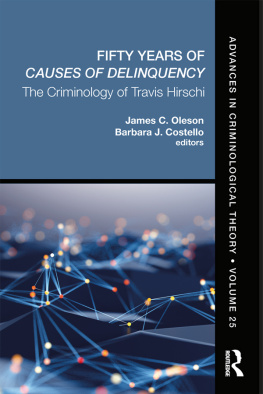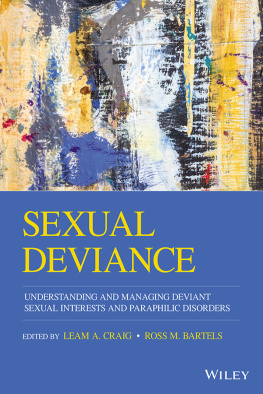
Control Balance
Crime & Society
Series Editor
John Hagan, University of Toronto
EDITORIAL ADVISORY BOARD
John Braithwaite, Robert J. Bursik, Kathleen Daly, Malcolm M. Feeley, Jack Katz, Martha A. Myers, Robert J, Sampson, and Wesley G. Skogan
Control Balance: Toward a General Theory of Deviance,
Charles R. Tittle
Alternatives to Imprisonment: Intentions and Reality,
Ulla V. Bondeson
Inequality, Crime, and Social Control,
edited by George S. Bridges and Martha A. Myers
Rape and Society: Readings on the Problem of Sexual Assault,
edited by Patricia Searles and Ronald J. Berger
FORTHCOMING
Great Pretenders: A Study of Property Offenders,
Neal Shover
Poverty, Ethnicity, and Violent Crime,
James F. Short
Crime, Justice, and Public Opinion,
Julian Roberts and Loretta Stalens
Crime, Justice, and Revolution
in Eastern Europe, Joachim J. Savelsberg
Crime and Public Policy: Putting Theory to Work,
edited by Hugh D. Barlow
Youth and Social Justice: Toward the Twenty-First Century,
Nanette J. Davis and Suzanne E. Hatty
The White Collar Offender,
Michael Benson and Francis T. Cullen
Control Balance
Toward a General Theory of Deviance
Charles R. Tittle
Crime & Society
First published 1995 by Westview Press
Published 2018 by Routledge
711 Third Avenue, New York, NY 10017, USA
2 Park Square, Milton Park, Abingdon, Oxon OX14 4RN
Routledge is an imprint of the Taylor & Francis Group, an informa business
Copyright 1995 Taylor & Francis
All rights reserved. No part of this book may be reprinted or reproduced or utilised in any form or by any electronic, mechanical, or other means, now known or hereafter invented, including photocopying and recording, or in any information storage or retrieval system, without permission in writing from the publishers.
Notice:
Product or corporate names may be trademarks or registered trademarks, and are used only for identification and explanation without intent to infringe.
Library of Congress Cataloging-in-Publication Data
Tittle, Charles R.
Control balance: toward a general theory of deviance/Charles R. Tittle.
p. cm. (Crime & society)
Includes bibliographical references and index.
ISBN 0-8133-2631-1. ISBN 0-8133-2632-X (pbk.)
1. Deviant behavior. 2. Social control. I. Title. II. Series:
Crime & society (Boulder, Colo.)
HM 291.T565 1995
302.5'42dc20 95-18229
CIP
ISBN 13: 978-0-8133-2632-0 (pbk)
For help on this book I owe the most to Debra Curran, who not only supported and encouraged me when I wanted to quit but who also served as a sharp critic, sounding board, proofreader, and general adviser. Raymond Paternoster, Harold Grasmick, David Ward, and Austin Turk read early versions of various sections of the manuscript and offered much constructive criticism. Critiques of the entire manuscript by Valerie Jenness and Jim (James F., Jr.) Short were very helpful and greatly appreciated. Jennifer Longmire is to be commended for her fine work in preparing the diagrams. Thanks are also owed to the staff of Westview Press, particularly Jill Rothenberg and Jennifer Blandford, and to Michele Wynn, the copy editor. None of these people, however, contributed to the book's shortcomings.
Charles R. Tittle
1
The Problem with Simple Theories
Most theories of deviant and criminal behavior are straightforward and uncomplicated, usually setting forth one or two explanatory principles involving only a few variables that are assumed to apply to all instances of the particular form of deviance being explained. These can be called simple theories. Conventionally, simple theories are classified into six or seven major categories, with sublistings of variations on themes. The most popular categorical schemes identify strain, learning, labeling, control, opportunity, psychodynamic, and biological categories as the major divisions, but according to Pearson and Weiner (1985), the most important specific simple theories are differential association (Sutherland and Cressey 1978), anomie (Merton 1957a), Marxian conflict (Bonger 1916; Quinney 1970), social control (Hirschi 1969), labeling (Becker 1963; Gove 1975, 1980; Schur 1971), utilitarian/deterrence (Andenaes 1974; Becker 1968; Cornish and Clarke 1986; Gibbs 1975; Tunnell 1992; Zimring and Hawkins 1973), and routine activities (Cohen and Felson 1979). Each of these leading theories has followers, enjoys some empirical support, and seems sensible, at least in prescribed usage and in application to particular kinds of deviance or crime. No simple theory in the crime/deviance area, however, has proven to be more than minimally satisfactory in overall explanatory ability, in applicability to a wide range of types of deviance, or in empirical support for its tenets. All are plausible, yet they fail as general theories. This is easily illustrated.
Differential Association
Consider first simple cultural learning theories, the prime example of which is Edwin Sutherland's differential association theory (Sutherland and Cressey 1978, culture (Miller 1958; Wolfgang and Ferricuti 1967). Sutherland's theory specifically postulates that the likelihood of criminal behavior (or by extension, deviance) varies with the individual's criminal attitudes, values, motivations, and skills, learned from "excess" exposure to crime-favorable messages or "definitions." Cultural messages can be supportive, neutral, or contradictory to crime, and they will have various degrees of influence depending upon their source, priority, intensity, and frequency. Thus, the ratio of "weighted" crime-relevant definitions can vary widely from person to person. Some will have ratios less than 1, others will have ratios above 1, and still others will have ratios that are far greater than 1. Presumably, the more the ratio of weighted crime-favorable messages to weighted noncrime messages exceeds unity, the greater are an individual's chances of learning criminal orientations and of committing crime.
Cultural learning theories have a commonsense, experiential character, especially when applied to things like gang fighting, drug abuse, or corporate price-fixing. Successful practice of these forms of deviance requires some learning of norms, techniques, and attitudes. In addition, they are activities requiring the cooperation of other people, and they are usually undertaken in company. Hence, it is reasonable to imagine that individuals do these things because they have been in situations where these, or similar, activities have been socially defined as appropriate and have been practiced by people who were known to, and perhaps admired by, the individual. Further, since they are group activities, it is logical to think that individual practitioners feel some pressure to meet group (normative) expectations and that if they do participate in deviant activities condoned by the group or culture they will be recognized, supported, accepted, and perhaps honored by those with whom they are associated.
A cultural learning theory, however, can hardly be used to explain criminal or deviant acts that are individualized in character. If there are no social contexts in which a given behavior is normative and if there are few social definitions of the behavior as acceptable, or fun, or indicative of some desired trait or status, then cultural learning can scarcely play an important part in its production. Extremely unconventional, bizarre behaviors, usually thought to be evidence of mental illness, for instance, do not seem to be products of cultural learning. Consider the eating of feces, an activity sometimes practiced by psychotic people. In the United States, and probably in all other places in the contemporary world, this is highly unacceptable. However, to explain it by Sutherland's differential association theory we would have to assume that the feces eater had been exposed to more social definitions favorable to feces eating than to messages unfavorable to the act. In any case, where would an individual encounter any social messages favorable to feces eating, much less an excess of such definitions? Similarly, in the United States, suicide, except for the altruistic type, is not normatively acceptable, and there are few social definitions of nonaltruistic suicide as appropriate behavior in any circumstances (however, it may be becoming acceptable to end one's life if one is suffering from an incurable, expensive-to-treat disease). It is difficult, therefore, to maintain that U.S. citizens who commit suicide have been exposed to an excess of suicide-favorable messages. In short, feces eating and suicide, and other individualized forms of deviance or crime, simply do not lend themselves to a cultural learning explanation.







